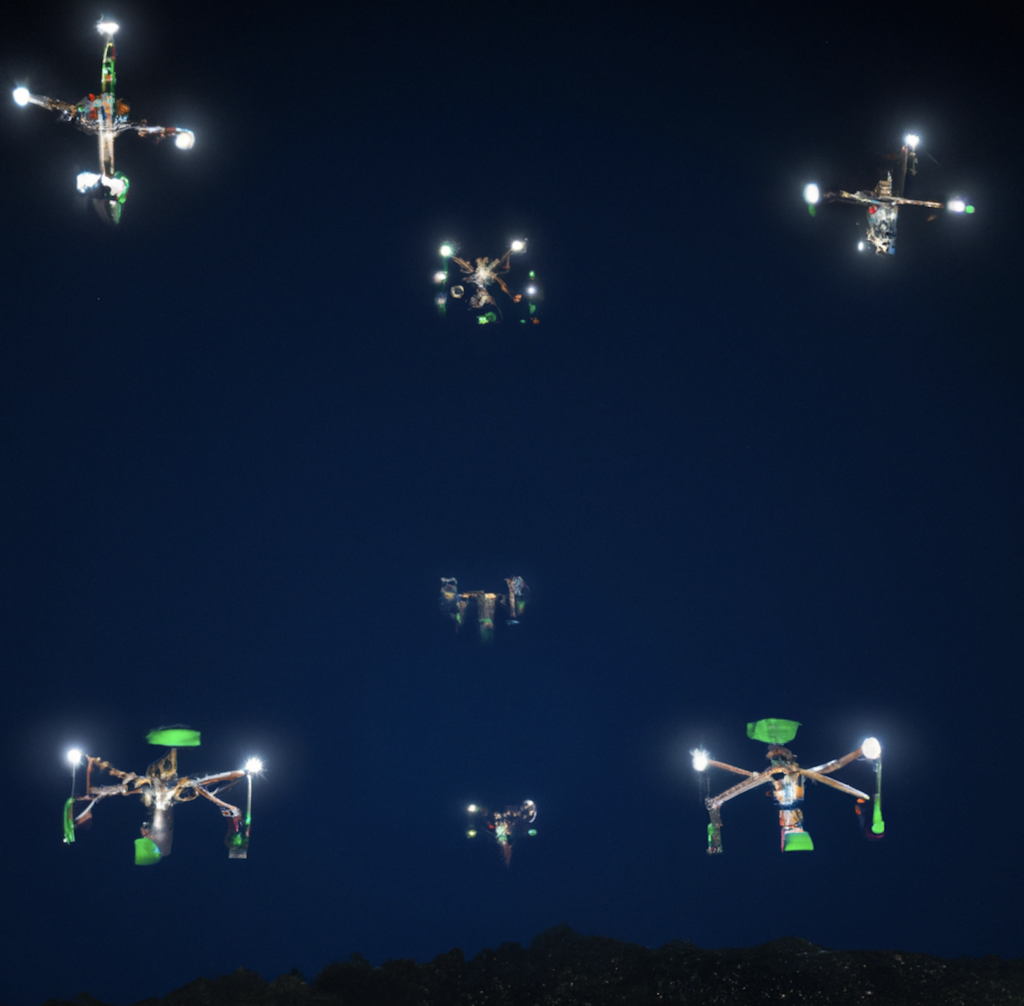
The EU’s U-Space regulation came into effect on Jan. 26, which marks a significant step for permitting complex drone and eVTOL operations. The onus is now on EU Member States, among others, to begin identifying airspace where the U-Space framework can be deployed. (Photo created using DALL·E)
This article is contributed by Richard Hakes, Oliver Beiersdorf, and Julia Norsetter of global law firm Reed Smith.
-

-
Julia Norsetter
-

-
Oliver Beiersdorf
-

-
Richard Hakes
January 26, 2023, marked an important milestone in making advanced air mobility (AAM) a reality in the European Union. Specifically, the EU’s U-Space regulation came into effect, which is a significant step for permitting complex drone and eVTOL operations. The onus is now on EU Member States, among others, to begin identifying airspace where the U-Space framework can be deployed.
The EU’s U-Space framework contains essential roles for EASA, the Competent Authority of a Member State (CA), Air Navigation Service Suppliers (ANSP), U-Space service providers (USSP). Briefly, the roles of these U-Space participants are as follows:
USSP. The U-Space service provider is a significant new entity in the airspace management of UAS and AAM. Generally, USSPs will rely on high degrees of automation and digital information to support safe operations for multiple UAS at once. Detailed requirements for USSPs are still under deliberation. A known essential function for USSPs will be the need to coordinate U-space services with existing air traffic management, described below under “Air Navigation Service Provider.”
EASA. Under the U-Space concept, EASA’s responsibilities include providing certification requirements and means of compliance for the USSPs, as well providing certification for some USSPs. In addition to EASA, Member States will play a significant role in USSP certification.
Competent Authority. The Competent Authority of a Member State is often its Civil Aviation Authority, such as the Directorate General for Civil Aviation in France. Under the U-Space concept, the Competent Authority’s responsibilities include designating the geographical limits of its U-Space, certifying USSPs based on EASA requirements, and ensuring a central authority for U-Space information coordination (“Common Information Service Provider”).
Air Navigation Service Supplier. An ANSP is an entity, often government or private, which provides air traffic navigation services to existing, traditional aviation. In the U.S., this service is provided by FAA’s “Air Traffic Control System.” Under the U-Space concept, the ANSP’s responsibilities will include coordinating data with the USSPs, as well as dynamic reconfiguration of the airspace to permit multiple operations.
The entry into force of the U-Space regulation marks the beginning of significant work for Member States, EASA and others. It will be important to move swiftly and safely towards a USSP certification process. USSP concepts are already well under design by industry providers seeking to be certified in this domain. In fact, a number of potential USSPs attended a January 26 meeting of the European Network of U-space Stakeholders Meeting in Helsinki.
EASA Operational Rules for eVTOL and UAS
The U-Space regulation comes on the heels of another important milestone in advanced aviation for EASA. In December 2022, EASA published rulemaking plans for vertical take-off and landing aircraft (VTOL) and Unmanned Aircraft Systems (UAS). This document will benefit VTOL and UAS operators who need approval of their flight plans. This news is significant for the emerging aviation industry, who will need multiple approvals from regulators like EASA in order to fly.
EASA has already made significant headway with the release of operational rules for low- and medium-risk UAS operations. Low- and medium-risk operations include those that generally do not fly over large groups of people, and have limitations relating to the weight and altitude of the UAS.
By contrast, the publication released in December 2022 relates to high-risk operations of both UAS and VTOL aircraft. This is significant because high-risk operations include the carriage of passengers and large cargo. Eventually, high-risk operations may also involve flight without a pilot on board.
Given the complexity of high-risk operations, it is no surprise that EASA plans to release information sequentially, as flights are tested for safety and eventually approved. For example, guidance relating to the carriage of goods will come far sooner than guidance for the carriage of passengers.
EASA plans to approach the high-risk category by proposing amendments to existing rules. Specifically, this information will be published in three tranches, as set forth generally below:
- Tranche 1: Manned VTOL aircraft carrying passengers or cargo in urban and non-urban environments; and certain high-risk UAS operations.
- Tranche 2: Manned VTOL operations carrying passengers or cargo, (that were unaddressed by the first opinion); and UAS operations taking/off landing at aerodromes.
- Tranche 3: UAS operations taking off in urban environments and unmanned VTOL operations carrying passengers or cargo.
EASA set forth high level information about the contents of its proposed amendments, which may include:
- Operational requirements for takeoff and landing at vertiports
- A new pilot’s license for VTOL operations
- Rules relating to the integration of high-risk operations into existing airspace
The upcoming opinions will also be accompanied by guidance material and a description of how to comply with the new requirements (“acceptable means of compliance”).
In its recent release, EASA notes the complexity of the regulatory architecture needed to permit VTOL and high-risk UAS operations. EASA’s planned consultative process for the tasks above is iterative and may result in additional proposals to introduce or amend existing rules.
With new regulations now entering into force, the EU has further demonstrated itself as a global leader in advanced aviation. There will certainly be a flurry of action as many sectors of industry work to understand and utilize the new rules. This will likely be an industry disruptor, considering the U-Space framework provides opportunities for many industries, including operators, service suppliers, and all potential beneficiaries of advanced air mobility.
EASA’s new U-Space framework and VTOL/UAS regulations will apply to EU member states. Manufacturers and operators seeking to fly in the U.S. will be regulated by the U.S. Federal Aviation Administration (FAA). Current FAA regulations allow for UAS operations and package delivery in specific circumstances under FAA approval.